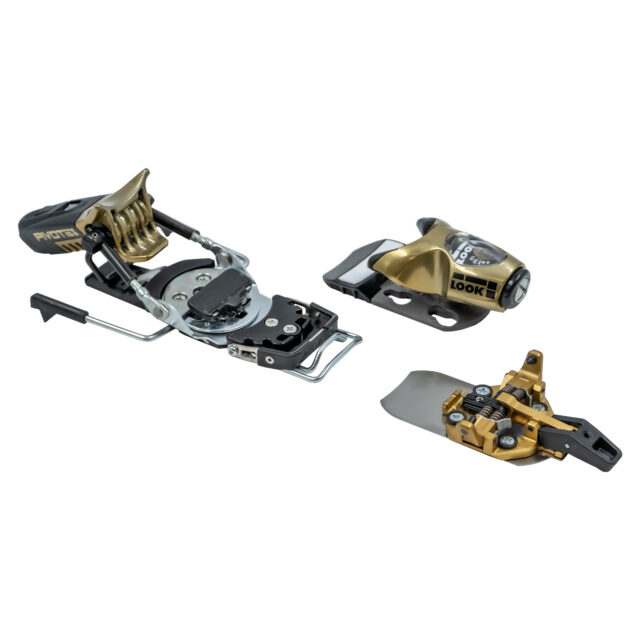
2022-2023 CAST Freetour Upgrade Kit
Release Value Range: 8-18 or 6-15
Climbing Aids: Flat, 8˚, and 12.5˚
Toe Stand Height: 20 mm
Boot Sole Compatibility: Alpine (ISO 5355), GripWalk (ISO 23223), or Touring (ISO 9523)
Available Brake Widths: 95, 115, 130 mm
Stated Weight: 1000 grams (touring weight)
Blister’s Measured Weight (Pivot 18 version):
- Alpine Toe pieces: 530 & 532 grams
- Touring Toe pieces: 125 & 127 grams
- Alpine Heel, climbing bail, & toe platform w/ 110 mm brakes (with screws): 870 & 872 grams
- Total Weight per Binding (All Parts Included): 1525 & 1531 grams
- Total Weight per Binding (On Ski While Touring): 995 & 999 grams
MSRP:
- Upgrade Kit (no Pivot binding): $349
- Freetour Pivot 15: $734
- Freetour Pivot 18: $734
- Second Ski Kit: $79
Skis Used: Moment Deathwish
Boots Used: Full Tilt Ascendant 10
Test Locations: Grand Teton National Park, Grand Targhee Resort, Teton Pass, & Jackson Hole Mountain Resort, WY
Days skied: 10
[Note: CAST has made some tweaks to the design, color options, and purchasing process of the Freetour system since we first reviewed the 18/19 version, which we touch on below.]
Intro
In the spring of 2017, CAST announced their new Freetour system, which they said would finally give backcountry skiers the efficiency of a pin binding to skin up, and the security of a dedicated alpine binding (the Look Pivot 18) for the down.
That’s the holy grail for a lot of skiers, and before we get into the nitty gritty of this review, it’s worth noting a couple of things:
(1) In our First Look at the CAST Freetour system, I called Lars and Silas Chickering-Ayers “the mad scientists at CAST.” That was an understatement, both on the “mad” and the “scientists” part. These guys have a unique combination of drive, experience, and technical skills that’s rare in the ski industry — starting an indie ski brand is a huge and terrifying undertaking, but it’s a whole ‘nother thing to start an indie binding brand.
(2) Somehow, two brothers operating out of the business park behind a gas station / burger joint in the tiny town of Driggs, Idaho managed to beat Salomon and Atomic to the punch on the whole “tours like a pin binding, skis like an alpine binding” thing, and various iterations of the CAST binding system have been on the market for several years now. (We reviewed the original CAST Si&I system back in 2013.)
(3) The Freetour system involves modifying a standard Look Pivot 18 or Pivot 15. You can either do this yourself if you already have a Pivot 18 or 15 (which we’ll discuss below), or you can order the system with the Freetour upgrade already installed on a Pivot 18 or 15 (see the specs above for the price breakdown).
Deep Dive Comparisons
Become a Blister Member or Deep Dive subscriber to check out our AT Binding Deep Dive where we directly compare the CAST Freetour, Marker Duke PT 16, Salomon Shift MNC 13, Fritschi Tecton 12, Fritschi Vipec Evo 12, Dynafit ST Rotation, G3 ION 12, & Marker Kingpin, and discuss what you tend to gain and give up by going to much lighter AT bindings.
How It Works
The Freetour is not a traditional ski binding system, it’s more of a conversion kit that turns a Look Pivot 18 or Pivot 15 into a touring-friendly tech binding. The system features a toe plate with shoulder screws that mounts to the ski, and then you can swap out a tech toe for skinning up, and use the Look Pivot toe piece when you’re ready to ski down.
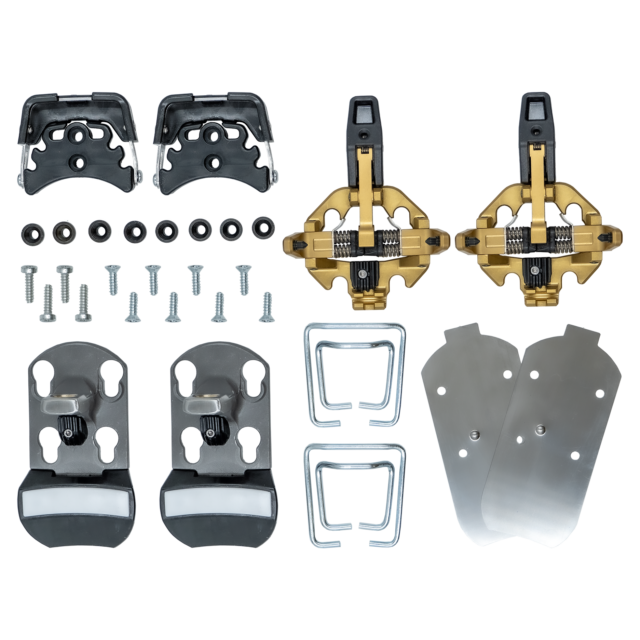
CAST offers the system pre-built, or you could convert your own existing Pivot 15 or Pivot 18 bindings. The conversion is relatively quick and easy — you just need a #3 Pozidrive screwdriver, and CAST provides step-by-step instructions here.
A couple more things to note:
- The CAST conversion does not work with the 12- or 14-DIN versions of the Pivot. You need to use the metal-toed 18-DIN or 15-DIN versions.
- CAST makes it clear that all bindings must be properly adjusted to the user’s boot sole length, height, weight, and release preference. The ski / boot / binding system must then be tested with the user’s boots in accordance with industry standards before use, to ensure proper function (just like you should with any alpine binding). They also note that if you are not a properly trained ski technician with the proper tools and a jig, you must have your bindings mounted by an authorized Look or CAST dealer.
Mounting and Swapping the Toe Pieces
Once you’ve converted the toe, you simply drill your skis for Pivots at your BSL like you normally would, with the addition of two more holes to hold the Freetour’s heel riser kit (CAST supplies a handy template for this). You then mount the heel and heel riser, and then mount the toe shim with the shoulder screws. Overall, this process is not much more involved than your typical Pivot mount job.
Once you’ve mounted the binding, you can swap the toes by pushing a small lever and sliding them off, as demonstrated in the video below. (CAST has several useful how-to videos and details on the system on their site.)
For the way up, you slide on the touring toe, flip up the brake lock that’s attached to the heel risers, and skin up. When you get to the top, slide off the touring toe, throw on the alpine toe, release your brakes, and go send.
Transitioning
Let’s get this out of the way: if your priority is super fast transitions, then this is not the binding for you. To transition, you have to take your foot out of the toe piece, then swap out the toe pieces. That takes a lot more time than just unlocking the toe and switching the binding heel piece as you would on many other tech bindings.
But the Freetour obviously isn’t aimed at the “multiple laps of low-angle, meadow-skipping” crowd, it’s aimed at skiers who want a dedicated alpine binding on the way down, not just one that transitions quickly.
There were a few times while transitioning where the toe piece didn’t slide off the shim plate easily, and required a little muscle to break loose. But a hit of lube on the plate and shoulder screws really helped there.
The brake lock on these bindings is awesome. I wish every binding used something similar. It’s simple, it never released when I didn’t want it to, and it’s easy to activate with a pole.
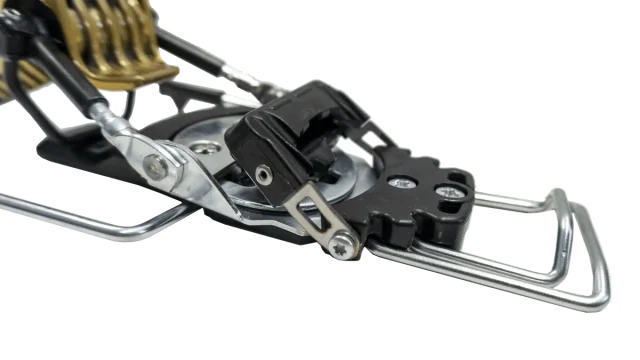
Climbing Bails
Like the brake lock, the Freetour’s climbing bails are awesome. Their 8° and 12.5° options hit my sweet spot for a variety of skintracks, they didn’t fall down while I was climbing, and they were easy to actuate with my pole. These things set the Freetour apart from the two other bindings that let you skin up in pin toes and ski down in an alpine binding (which only have a single climbing riser). Plus, the Freetour also has a truly flat option. Well done.
Touring Toes
CAST did something remarkable with their touring toes. On their old Si&I system they used converted Dynafit toes. For the Freetour, they fabricated their own tech toes. And that fact still blows my mind a little every time I transition on the Freetour.
That said, the finish and tolerances of the (original) Freetour’s tech toes I tested aren’t as tight as you’d expect from a typical touring toe, and I did run into some issues. If the touring toe isn’t settled perfectly on the shoulder screws, it’s impossible to lock your boot into the toe. That’s really, really frustrating when you’re trying to transition on a perfect pow day, your friends are all way ahead of you, and your ski keeps falling off when you try to step into it. CAST suggested doing a little work to the problem areas with a Dremel, and this helped, but even so, these toes caused a lot of hassle.
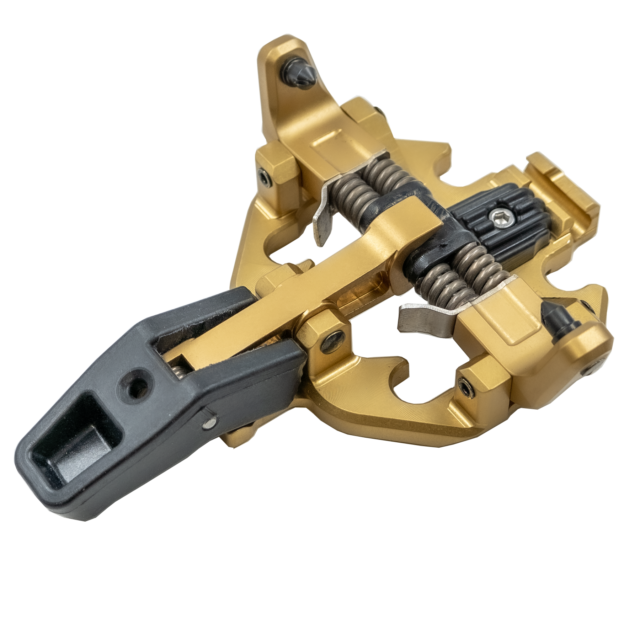
However, it’s important to note that CAST says they did a small redesign on the tech toes that reportedly fully addresses the tolerances issues I ran into with our original test pair, so we’ll update this review if / when we’re able to test out the redesigned tech toe. But from all the reports we’ve heard, the current tech toes are notably easier to use than the ones I tested.
But again, the Freetour isn’t aimed at skiers who prioritize simplicity, low weight, and quick transitions. It’s aimed at people who want to ski on burly, dedicated alpine bindings in the backcountry.
And on that note…
Downhill Performance
Let me put it this way: if you were to drop me on top of a steep, beat-up, cliffed-out, tracked-out, firm-snow Freeride World Tour venue, the Freetour is the only touring binding I would want to be in. It skis just like a Pivot 18 (or 15).
The Pivot 18 has a cult following for a reason. It’s sturdy, reliable, it’s made out of metal, it has a bunch of elastic travel, and it has a comforting “SNAP” when you step into it. Sure, it’s hard to get into when the heel has pivoted too far, it’s a pain to adjust for different BSL’s, and if you’re smaller and lighter its DIN range (8-18) may not work for you (though the 6-15 DIN range of the Pivot 15 might). But it is a downhill binding that many skiers count on and refuse to ski anything else.
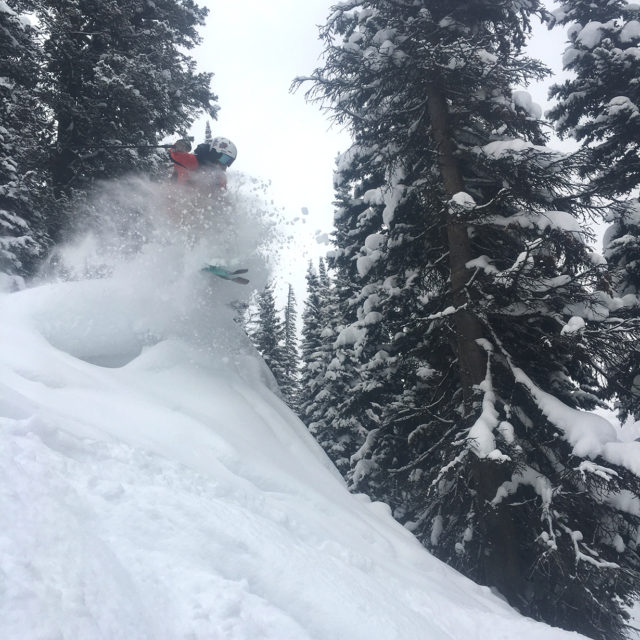
Again, the CAST Freetour skis just like a Pivot 18, because it’s essentially just a Pivot 18 that’s mounted on a ~2 mm metal plate. If that’s what you want your touring bindings to feel like, the Freetour is your only option.
Compatibility
You can get the Freetour system with an AFD for boots with Alpine soles (ISO 5355), GripWalk soles (ISO 23223), or Touring soles (ISO 9523). CAST says their Touring AFD will also fit boots with the old WTR soles, and also note that the “release and retention characteristics of [ISO 9523 boots] will be affected by the boot’s sole material and tread pattern.” Overall, the Freetour’s AFDs are easy to swap, and they feel solid.
In addition, CAST can also fit tech toe fittings into your alpine boots so that you can use them with the Freetour system. Note: CAST strongly recommends that you do not use such boots (i.e., boots that have been converted for use with the CAST Freetour) with other tech bindings where you’re skiing downhill on the toe pins (CAST’s inserts are not designed to be skied on, only skinned on). CAST does say that their conversion will work with the Atomic / Salomon Shift binding and Marker Duke PT, since, in that case, you’d only be skinning with the inserts, not skiing on them.
Weight
The Pivot 18 and Pivot 15 are heavy bindings. The Freetour system uses most of a pair of Pivots, so by default, it’s not light. However, that comes with a few caveats:
There are two ways to measure the weight of the Freetour system. You can look at the entire weight of the system, or you can look at how much weight is actually on your skis.
CAST prefers to look at that second number, and I mostly agree.
The weight you’re dragging on each foot is much more important than the weight in your pack. Don’t believe me? Try skinning your favorite lap with a beer taped to each ski, then do a second lap with those two beers in your pack. You’ll have a better time (and less head on your beer) with the beers in your pack.
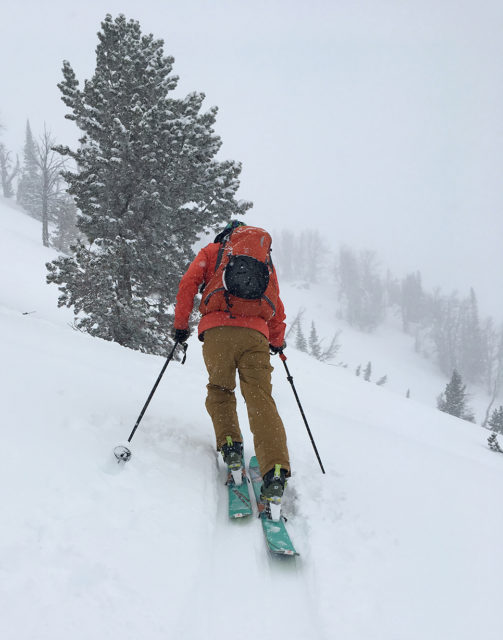
However, the weight of those alpine toes in your pack still counts for something, and the Freetour is still heavier than most touring bindings. At just under 1000 grams on each ski with the Pivot 18 setup, the Freetour system is ~200 g heavier per foot than the Marker Kingpin 13, and ~120 g heavier than the Shift. In terms of on-ski weight, the Freetour is a bit lighter than the new Marker Duke PT 16 (though the Freetour is heavier in terms of overall weight).
An important thing to again consider is that the Freetour with the Pivot 18 has a max DIN of 18, while those other options only go to 13 or 16. In fact, the Freetour is still the only touring binding out there that has a max DIN of 18.
On the skin track, I can’t say I really noticed the weight of the Freetour. Personally, I find that other factors like the weight of your boots, skins, skis — and how much you drank the night before — have a bigger cumulative impact on how heavy your setup feels.
For reference, here are some of our measured weights (average per binding) for a few notable bindings:
626 g Dynafit ST Rotation 10 (105 mm brakes)
638 g G3 ION 12 (105 mm brakes)
682 g Fritschi Tecton 12 (120 mm brakes)
775 g Marker Kingpin 13 (75-100 mm brakes)
886 g Salomon S/Lab Shift MNC 13 (110 mm brakes)
997 g CAST Freetour w/ Pivot 18 (weight on ski while touring; 110 mm brakes)
1074 g Marker Duke PT 16 (uphill mode w/ alpine toe removed; 125 mm brakes)
1383 g Marker Duke PT 16 (downhill mode; 125 mm brakes)
1478 g Salomon Guardian MNC 13 (115 mm brakes)
1530 g CAST Freetour w/ Pivot 18 (all parts included; 110 mm brakes)
Comparisons
The Freetour replaces CAST’s Si&I system, and improves on it in almost every way. It’s lighter, less fiddly, and you don’t have to rubber-band your brakes.
However, the Freetour system has some other big competitors: frame bindings, tech bindings, and other alpine-like AT bindings, the Shift and Duke PT. If you want a very in-depth comparison on how the Freetour compares to the Shift, Duke PT, and several other downhill-oriented touring bindings, you should definitely check out our AT Binding Deep Dive. Here, I’ll go over the very brief, general trade offs.
Frame Bindings
The Freetour is a huge improvement on frame bindings. The Freetour tours and skis better than any frame binding. The Freetour is much lighter while touring, it has a lower stack height, a better-optimized pivot point, nothing attached to your heel while touring, and is similarly as fiddly to transition. The Freetour loses on price, but the improvement that comes from touring on a real tech toe is absolutely worth it in my opinion.
Lighter AT Bindings
Compared to all “tech” or pin bindings on the market right now, the Freetour is heavier, has a higher max DIN, skis much better, and takes a lot longer to transition. The Freetour skis better than any tech-toed binding I’ve been on (including the Kingpin and Fritschi Tecton). The Freetour feels less jarring in rough snow, more secure, offers better power transfer, has much more elasticity, and I’d trust it much more to both release and hold me in when I want it to. But it has a longer and more involved transition process, and it’s pretty heavy.
So if you’re considering the Freetour, just get very clear on your priorities in the backcountry. For a lot of skiers who aren’t pushing their limits while touring, lighter touring bindings will be the obvious answer.
But if you’re going out to hit a booter, big cliff, steep spine line, etc. — or you simply want much more elasticity and more reliable release characteristics than any tech binding offers — I think the Freetour is a much better option than any tech binding available.
Who’s It For?
The Freetour is a bit of a niche product. Not that many people are looking to go huge in the backcountry. Not everyone needs an 18-DIN or 15-DIN binding. And not everyone has the patience to deal with swapping toes. But if you’re filming your movie segment and/or skinning to hit big booters and high-consequence lines, the Freetour makes more sense. Or if you just want a binding that you can have zero qualms about skiing really hard in the resort, but that also makes it easy to tour, there’s also a strong argument to made for the Freetour.
And then if you just want to be able to ski Pivots or have an 18-DIN binding in the backcountry, the Freetour system is the only option that you can tour on.
For most other skiers, lighter touring bindings will make more sense, but the Freetour definitely has its place.
Bottom Line
For skiers who want the venerable downhill performance and reliable release characteristics of a Pivot 18 or Pivot 15 and the touring efficiency of a tech toe, the CAST Freetour system is not just the only option, but a well-executed one.
Deep Dive Comparisons
Become a Blister Member or Deep Dive subscriber to check out our AT Binding Deep Dive where we directly compare the CAST Freetour, Marker Duke PT 16, Salomon Shift MNC 13, Fritschi Tecton 12, Fritschi Vipec Evo 12, Dynafit ST Rotation, G3 ION 12, & Marker Kingpin, and discuss what you tend to gain and give up by going to much lighter AT bindings.

Hi Cy,
Thanks for this great review. I recently bought a pair of Praxis Protests and am looking into binding options. My primary use for the skis will be heli and cat skiing but it would be good to have them available for the odd short tour / side country trip. I’ll likely just use alpine boots so am wondering if you’d recommend these or something like the Tyrolia Adrenaline (not necessarily them but something like them)?
After reading this, the other option I could have is to convert my blizzard gunsmokes which currently have the Pivot 18 on them and just get alpine bindings for the Protests…
Appreciate your advice,
Davyn
I confirm that the production version still has some issues with the dyna toes. Tolerances are really not that good, so some filing/ dremel is necessary in order to avoid the toes getting stuck/ not sliding in.
For the rest, it’s the best system around. I already have 3 pairs of SI&I (STH16 x2 + FKS) and apart from the weight saving, the new version also makes it way easier and quicker to go from ski to tour and vice versa, without extra elastic bands (which tend to get cut by the edges). Also, it reduces the stack height which in the SI&I is around 6mm.
Although I also own a pair of Salomon Shift, the slight weight penalty of the CAST Freetour is definitely worth as there’s no other binding that gives you the same feeling as an FKS/ pivot.
Just another “skier type” considering this binding and wanting to weigh in…
One of the benefits I see to the system is the additional kit offered for $100. I have P18s on 3 pairs of skis. How cool would it be to have a full quiver of touring skis at your disposal on a given day? There are definitely days here in the wasatch where my 120mm waisted Renegades would be worth hauling up if I had the option.
That said I’m still on the fence between this and Shift but for a skier in my position this makes it a more interesting prospect!
Hello guys! I´m doing my Research for a new pair of touring/skiing binders… So far I´ve been using the duke (too heavy) and the kingpins 13 with too many issues: broken heel, pins, and the last one: loose screws in the toe piece. Just to clarify: the toes where correctly installed, the issue apair one day after a pretty icy steep tour wuth lots of “on edges” sections…
I´m a heavy dude 210lbs + gear and I ski pretty hard. So I´m always looking for durable gear (that´s why it took me a lot of time to move from frame to pins, till I got tired of dragging too much weight in long days). So, the option appears to be pretty valid. Should i go this way? try the shifts (I try em ones, but the brakes kept poping out every time). I just don´t want to deal with more gear issues. At least for some time… Thank you!!!!
Hey,
I think you and I are in the same situation. I am also around 210lbs and ski quite hard. Last year i bought a pair of salomon shift to go on my super 7 HD ski. Even though the shop mounted the binding at the highest DIN I had to releases mid turn in full speed. Really scary not to be able to trust the binding.
I will be looking a selling my bindings and moving to something more solid. I hope the Cast system will finally be what I’m looking for.
Count me in as another 200 lb guy looking for something burlier than a Shift. Besides, I’ve never really trusted Salomon bindings ever since I dislocated my shoulder after a pre-release on Salomon’s while skiing moguls and always had to run 3-4 higher Din on Salomon v Pivots. I feel like the Cast setup is for those of us looking for the ski equivalent of an enduro mountain bike. Most of the backcountry ski setups are like an xc bike. In the summer, my xc bike generally collects dust while I’m on my enduro. I’m willing to work a little more on the up to know I have the right setup for going down. I have a lot of good side country options to hit up on a powder day after skiing a morning of powder (or the days after a storm) and don’t want to be bothered to go back to the parking lot to change gear. There is no pin toe setup I trust to thrash in bounds. I have Beast 14s for my dedicated BC setup and they are already kinda a pain on the transitions, So I don’t think the Cast would be much slower. I’m very close to pulling the trigger on these
Hey pro tip calling bindings “binders” is extremely cringey for most people, you may want to reconsider calling them that.
Who cares?? Let the guy call it what he wants. You obviously are too sensitive to what people think.
Im not a super big guy (185 plus gear) and ive broken 2 Dynafit radical 2.0 heels, they warrantied the first breakage but not my more recent one. I live in Alaska and the terrain and temps can be brutal on gear. If you’re dropping cliffs and skiing wind blown crud and you need to 100% trust your bindings this is really the only way to go. This is also great for people that do 70-30 resort/touring and will only use them in the backcountry a few times a year because it offers a real binding for the resort days. Also these aren’t that heavy really, only 350g more then my radicals, just bring whisky instead of a 6 pack and youll be fine.
Love your review. Just want to provide some feedback on CAST vs. Shift for your research and for anyone else reading this.
I’ve been through the wringer with the Shift. I am 210lbs, ski hard and love the backcountry. The Shift is not at all designed to keep up with that. With the DINs maxed out I was still popping out all over the place and actually broke the wing of the toe piece clean off. This also happened with another friend I ski with.
As soon as Salomon warranties these bindings I am selling them to get a CAST system. Absolutely zero trust left in the Shift. Thank you for your review, super helpful and in depth as always!
-Nick
My review will be a bit negative and positive.
When I received my bindings the boot conversion was done wrong. The company offered minimal to no help solving the issue. It took me two months… two months!… to get them to fix the issue. The bindings fan additionally be difficult to mount with very few ski techs knowing how to fix or work on the bindings. Two shops told me they don’t work on cast bindings because of how frequently people come in with unrepairable issues. I eventually found a ski tech to work on them. He thought he figured it out so I took the skis to japan, the fix didn’t work. I took it to ski techs there and they let me use a pair of touring skis because they felt bad. They said they see people every year who have the same thing happen with cast.
All in all, the company is very easy to get on the phone if they are making a sale. After that it’s all on you to get it to work. My recommendation is to find a ski tech who has mounted cast before you buy them. Do NOT accept a refund from this company. You CANNOT remount the skis with another binding after drilling holes for the cast system. So if your system fails. You are stuck dealing with potentially the worst customer service department on the face of the earth or tossing your skis. If you do a boot conversion your bindings will not work for new touring boots as well. The new boots have a different rubber grip under foot than their conversion so you will have to buy new parts which runs another $200 to convert the bindings over to a typical new touring boot.
Be conscious of this before purchasing.
Bummer about your boots, but I’m not sure I follow the rest. The mounting is nearly exactly identical to mounting regular Pivots, so every shop in the world should be able to mount them up. And you sure can remount after using them, especially easy if you just put Pivots back in the same holes, or worst case fill the holes and fire away. For the different boot sole standards, they sell the AFD’s you need for $15.
I know I’m digging up and older one…
How far forward does your pivot point become in tour mode? So, if I mount recommended boot center, will I simply be 1cm forward or more? Wondering how it changes swing weight/breaking trail with tip rocker.
As always, thanks for the wonderful write ups.
In the previous review about the Si&I system (https://blisterreview.com/gear-reviews/cast-sii-alpine-touring-system), the author wrote “I also find that having the extra weight of the heel on the back of the ski actually helps during a kick turn, as the ski immediately pivots into place with the ski tip to your knee. The SI&I system kick turns easier than anything else I have been on.” So not exactly what you’re getting at, but it was a thorough enough review that I’m sure he’d have mentioned an issue like that. I didn’t measure mine, they just work.
I’m an ex World Cup downhiller and only ski with Look Pivot bindings as they are the safest alpine binding. On Salomon, Tyrolia, Marker etc I had to set at 12-14 but on Pivot binding I ski all season on 9.5.
My knees are in good shape, the Pivots release when I need them to and never prerelease.
I started ski touring last year and detest the compromises with touring ski’s and bindings ! I don’t trust those Dynafit binding at all so I’ve bought the Cast system.
It arrived today, I have a pair of Stöckli Stormriders 186 ready to mount up and I’m excited !
Couldn’t agree more on nearly all points. I do use Ion’s (Dynafit-like) as well, they’re just a different compromise: lighter, less safe for the knees. They mostly get used in soft snow with less trees around though.
Sweet write up and thanks. Just looking at these as part of my new setup for next season as I start getting into touring (70kg / 170cm). I’m going for the Pivot 15s on some Wagner Customs and couldn’t be more excited. It’s going to take a while to get into the touring and so having a bullet proof binding for the frontside/resort as the transition goes makes perfect sense. No issue with the time taken to switch. I’ll update here after a few days on the new gear when it arrives for the 22/23 season.
I broke a femur, rib and vertebra last May when a tech toe pre-released while hauling ass and it’s been tough to trust any tech binding since. I pulled the trigger on the Cast system as soon as I read about it and they’re getting mounted tomorrow. Pretty excited to not be constantly second guessing my bindings on the down.